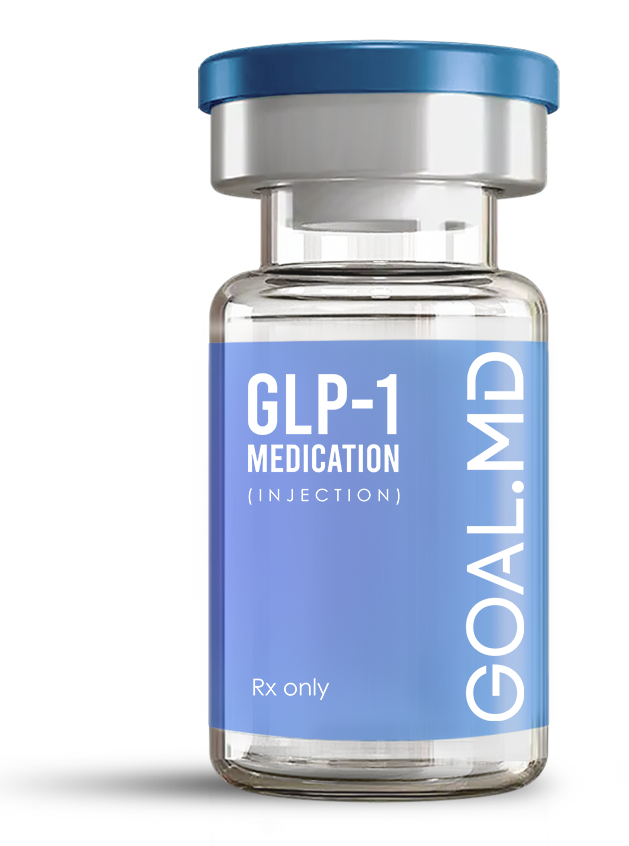
GOAL.MD Health & Wellness Blog
Evidence-based insights, medical weight loss information, and practical tips from our physicians and healthcare experts.

GLP-1 Side Effects 101: What’s Normal, What’s Not, and How to Handle It
GLP-1 Side Effects 101: What’s Normal, What’s Not, and How to Handle It
GLP-1 medications, such as Semaglutide (Ozempic®, Wegovy®) and Tirzepatide (Mounjaro®, Zepbound®), are transforming the way we approach weight loss, PCOS, and metabolic health. However, let’s be honest—while the results can be life-changing, the side effects can come as a surprise.
If you’ve experienced nausea, bloating, or appetite shifts since starting a GLP-1, you’re not alone. This guide breaks down what’s normal, what’s not, and how to handle it like a pro, so you can stay on track and maximize your results.
Why Do GLP-1s Cause Side Effects in the First Place?
GLP-1 receptor agonists mimic a natural hormone that:
Slows gastric emptying
Regulates appetite via the brain
Boosts insulin and reduces blood sugar spikes
Lowers inflammation and cravings
These shifts are incredibly beneficial—but they also disrupt your old metabolic rhythm. As your body adapts, it’s common to experience side effects—some minor, some frustrating, and a few that are worth flagging to your healthcare provider.
Common (and Normal) Side Effects of GLP-1 Medications
Mild Nausea
Why it happens: GLP-1s slow digestion and reduce food reward, which can temporarily trigger queasiness.
What to do:
Eat smaller, protein-forward meals
Avoid greasy, spicy, or sugary foods
Sip ginger tea or chew ginger chews
Stay upright after eating
Bloating and Gas
Why it happens: Your food digests more slowly, leading to fermentation and gas buildup.
What to do:
Increase fiber slowly
Avoid carbonated drinks
Use peppermint tea or digestive enzymes
Loss of Appetite
Why it happens: The medication is doing its job—dampening hunger signals.
What to do:
Eat when you’re hungry, not by the clock
Focus on protein and hydration to avoid nutrient gaps
Constipation
Why it happens: Slower motility + reduced food volume = slower bowels.
What to do:
Drink 2–3 liters of water per day
Add chia seeds, flaxseed, or magnesium citrate
Walk daily and stretch your core
Fatigue or “GLP-1 Fog”
Why it happens: Could be linked to electrolyte shifts, blood sugar changes, or under-eating.
What to do:
Ensure meals have enough calories and protein
Add electrolytes to water (especially magnesium, sodium)
Don’t skip meals entirely
Less Common but Manageable Side Effects
Mild Headaches
Often related to dehydration or carb withdrawal.
Solution: increase water intake, consider caffeine if you’ve reduced it suddenly.
Feeling Cold
As body fat drops and metabolism shifts, some patients report being chilly.
Solution: eat enough healthy fats, layer up, stay active.
Burping or Reflux
GLP-1s can cause stomach content to linger, increasing pressure.
Solution: eat slowly, avoid acidic/spicy foods, stay upright post-meal.
What’s Not Normal (Call Your Provider)
While most side effects are mild and temporary, some symptoms need medical evaluation.
🚩 Severe Vomiting
Could indicate intolerance, dehydration, or a dose too high.
🚩 Persistent Diarrhea
May lead to electrolyte imbalance or mask another condition.
🚩 Sharp abdominal pain (especially upper-right quadrant)
Could suggest gallbladder issues—GLP-1s increase risk in rare cases.
🚩 Pancreatitis Symptoms
Severe abdominal pain radiating to the back, nausea, fever—go to the ER.
🚩 Unintended Rapid Weight Loss or Muscle Loss
May require dose adjustment and nutrition support.
Always report symptoms that feel intense, persistent, or unusual.
How Long Do Side Effects Last?
Most side effects peak in the first 2–6 weeks, especially during dose escalation. Once your body adjusts to a consistent dose, symptoms typically improve—or disappear entirely.
Slow titration is key: Avoid jumping doses too fast. Start low, go slow..
Top 5 Tips to Minimize GLP-1 Side Effects
Don’t skip meals – Smaller meals are better than none. Undereating can make nausea worse.
Hydrate like it’s your job – Water, electrolytes, and fiber are your side-effect shield.
Stick to gentle movement – Light walking, stretching, or yoga improves digestion.
Choose your foods wisely – Prioritize protein, avoid fried and sugary foods.
Communicate with your provider – Never suffer in silence. Most side effects can be managed or minimized with support.
Will Side Effects Return if I Increase the Dose?
They can—but often they’re milder the second time around. Be especially mindful during dose increases and give your body at least 4 weeks to adapt before escalating again.
If symptoms return, your provider may advise holding at a lower dose or spacing out your dose frequency temporarily.
Need Help Navigating Your Side Effects?
At GOAL.MD, we don’t just prescribe GLP-1s—we support you through every phase of the journey.
✔️ Personalized symptom tracking
✔️ Nutrition coaching to minimize nausea & fatigue
✔️ Smart titration plans
✔️ Gut and hormone optimization
✔️ 1-on-1 clinician check-ins
Final Thought: Discomfort Is Temporary. Results Are Not.
Side effects are common, but they’re also a sign that your biology is shifting. With the right support, GLP-1 side effects become manageable—and for most patients, worth it.
Because when your body gets quiet… when the cravings stop… when the inflammation cools down…
You realize: this isn’t just a diet.
It’s a reset.
Why GOAL.MD?
✅ Sourced from audited 503a US compounding pharmacies.
✅ Custom dosages adjusted to your needs.
✅ Free consultation + 24/7 support.

How It Works
1. Quiz
90 seconds. No commitment.
2. Consult
Video chat with your GOAL.MD doctor.
3. Deliver
Meds at your door tomorrow.
Transform Your Life with Physician-Directed Care
Join thousands who've found success with physician-directed care. Take our 3-minute quiz to see if medical weight loss is right for you.








